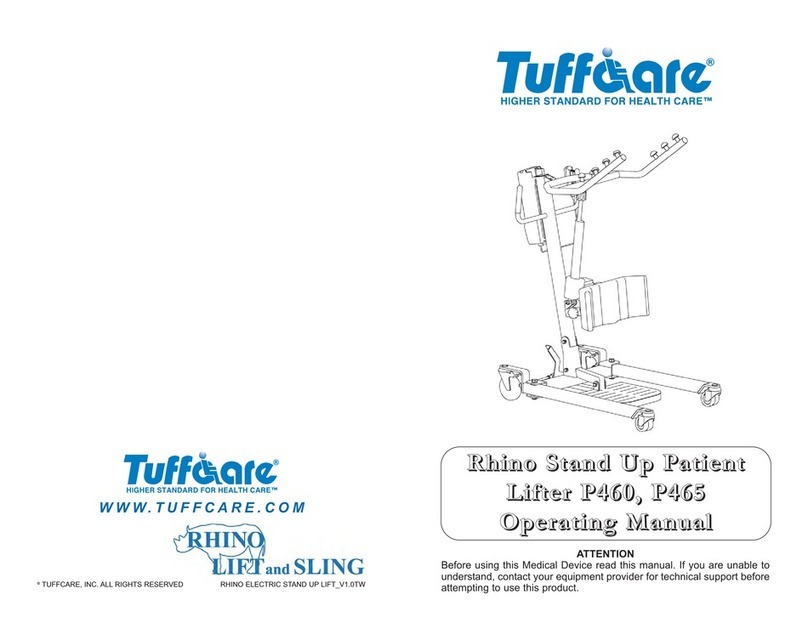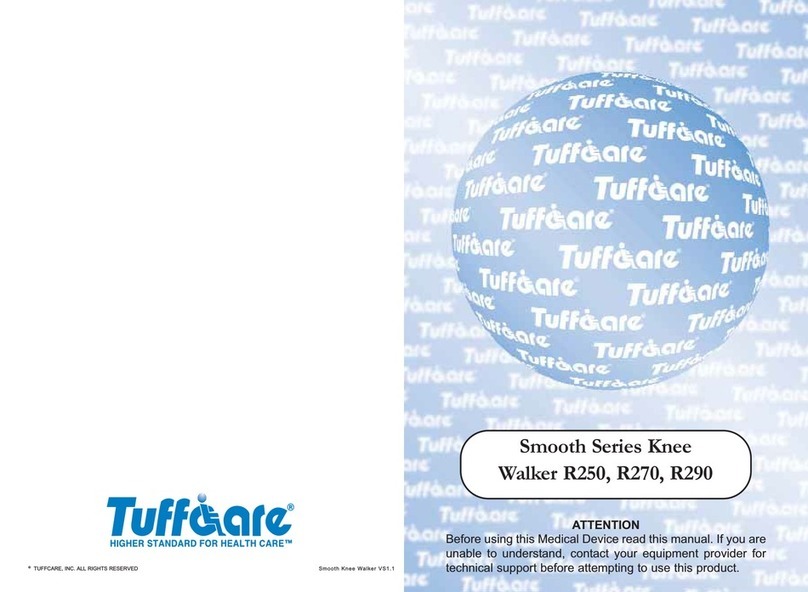-4- -5-
Wheelchair seat and backrest angle adjusting precautions:
This wheelchair provides the option of adjusting the angle of the seat and
backrest according to every user's needs. The option of adjusting the angle of the
seat and backrest bring more comfort to the user on the wheelchair. The
adjustment of seat and backrest angle will need the assistance of an attendant.
The attendant must hold the pushing handgrip and push the cylinder with the
thumb (as shown in the picture, left side: backrest cylinder handgrip; right side:
seat adjusting cylinder handgrip. Both can be used independently or
simultaneously). Elevate or push gently the handgrips with both hands and adjust
to the suitable position, then release the hands to adjust the angle of the seat and
backrest.
Safety recommendations
1. The maximum capacity for this wheelchair is 280lbs for 18” wide, 330lbs for 20”
wide. Users over the weight limit, please contact the manufacturer to purchase a
customized product.
2. For self propel wheelchairs, the user should maintain a uniform speed. The
recommended max. speed for self propel use is at 3mph.
3. The wheelchair is recommended to be used on flat ground. If any obstacle
appears, please veer away to avoid any danger of wheelchair tipping and falling.
4. While using the wheelchair, the user should not stand on the footplate as this act
will cause danger of tipping and falling.
5. The user must assure to have good seating positioning before using the
wheelchair on sloping ground. The angle of the sloping ground should be no
more than 10 degrees for safety considerations. If the angle of the sloping ground
is over than 10 degrees, there must be an attendant to assist the user to push the
wheelchair at the back.
6. Do not tilt or swerve while the wheelchair is being used on sloping ground. Using
brakes abruptly when going downhill is not recommended as this will
cause danger of tipping and falling to the front.
Precautions
Precautions
Using the brakes
The wheel locks (on model No. 456E & 457E) or brakes ((on model No. 456E &
457E) should be engaged against both rear wheels or casters before sitting down
or getting up from the chair.
Self Propel Wheels (Handrims)
The user must first sit steadily on the wheelchair, grab the handrims with his/her
hands and push the handrims forward with the same force on both hands to make
the wheelchair move forward, then release both hands off the handrims. When
the wheelchair has slowed down its speed after moving on certain distance of
movement, please repeat the above procedure.
Way to go upstairs
When the wheelchair is going upstairs, the user must have an attendant who will
be assisting at the back of the wheelchair. The attendant must step hard on the
pedal located besides the rear wheels, so the wheelchair may incline backwards
and tilt the front wheels to achieve the height of the next step of the stairs. Push
the wheelchair forward a little and loosen the feet from the pedal so the front
wheels may touch the step. The attendant must push the wheelchair hard so the
rear wheels may move forward to the next step. Repeat the procedure until the
wheelchair achieves its destination.
Way to go downstairs
When the wheelchair is going downstairs, the user will need two attendants for
assistance, one at the front and the other at the back of the wheelchair. To be able
to go downstairs, the attendant at the back must hold the handgrips tight to assure
the wheelchair will not fall off the stairs. The attendant at the front must step down
first and elevate the front frame of the wheelchair, then slowly and carefully pull
the wheelchair down from the stairs. Repeat the above procedure until the
wheelchair achieves its destination. Finally, the front attendant must put down the
front frame of the wheelchair so the front wheels can touch the ground.



























